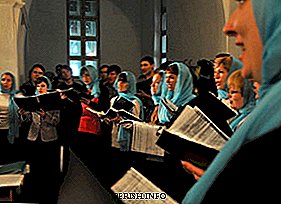 The history of church singing goes back to deep hoary antiquity. Christ himself set an example, when, after the Last Supper, "singing" went to the Mount of Olives accompanied by his disciples.
The history of church singing goes back to deep hoary antiquity. Christ himself set an example, when, after the Last Supper, "singing" went to the Mount of Olives accompanied by his disciples.
“Sing to our God, sing” - the psalm says, and founded by the Lord himself, existing for more than twenty centuries, the Church has preserved the tradition of song praising the Creator. In the lives of the saints we often read about how pious old men and youths were granted the visions of singing angels. As the legend says, Saint Ignatius, nicknamed the God-bearer, conveyed the heard image of the church in Antioch.
The Trisagion song that came to us, "Holy God, Mighty Holy ..." "was born" in the V century AD. e., according to church tradition, after the earthquake in Constantinople, when a certain lad heard the angelic choir. The incredibly deep meaning of this ancient prayer is that the earthly and heavenly churches are united during the divine service, and the Lord sends his blessing to praying people.
How did znamenny chant appear in Russia?
The history of church singing in Russia begins in the 10th century, when Prince Vladimir invited the Greek clergy and spiritual singers to Kiev. They also brought the so-called znamenny chant with them. The process of formation of the znamenny Russian osmogoliya, which began in the 12th century, was completed only by the beginning of the 16th century.
It is also worth noting that it is precisely on the basis of osmogony that such "know-how" of church-song art as track, line and demestvennoe singing is created. It was in the 17th century that a peculiar flowering of Russian znamenny singing took place, after which, as, probably, in any kind of art, a rather long stagnation is observed, and then a decline.
From znamenny chant to parthesny singing
Polish influence on Russian church singing is indisputable. However, the relationship between Catholic and Orthodox Christians was by no means warm, and, as a result of the struggle with the union, the Orthodox Kiev brotherhoods developed a fundamentally new type of singing, different from the sound of the Catholic organ.
Beginning in the second half of the 17th century, the transition from Znamenny chant to parthenal takes place. Patriarch Nikon very actively contributed to the spread of party singing, which was performed under the guidance of Belarusian and Kiev regents. The main difference in the singing of invited Kiev "Spivak" was that their style seemed much softer and more melodic than the "Muscovites".
Chants were recorded, again, in Kiev, that is, with the help of the notation that has become classical - the five-line one. The notes, the so-called "Kiev flag", were square, but the hook notation from church use gradually disappeared, and soon completely disappeared. The official “birthday” of party singing is considered to be the year 1668, when the ban on polyphonic singing in the Russian church was finally canceled.
An important role in the development of this singing in Russia was played by a prominent musician Nikolai Pavlovich Diletsky. Based on his theory, Russian church singers quickly grasped the basics of the new art.
Church music in the style of classicism
In the XVIII century, a new stage of church chants began, the style of which was formed under the influence of Italian composers. So, Giuseppe Sarti somewhat "modernized" the ancient song-hymn of the Bishop of Ambrose of Milan, "We praise God to you." Under the influence of Sarti, the song acquired not only pomp (the “premiere”, held in 1789, accompanied by gunfire), but also Italian elegance.
Remarkable followers of the Italian school were such prominent composers as M.S. Berezovsky, A.L. Wedel, creator of the first national anthem “Kohl is glorious is our Lord in Zion” D.S. Bortnyansky and S.A. Degtyarev.
Yes, the history of church chants shows that the church was also subject to the “whiff of times”, and only after the intervention of Emperor Paul I, were the lightweight “worldly” compositions excluded from the church “repertoire”.
But the tradition of the spiritual concert is still alive today. At the end of the Liturgy, the choir often performs a modern psalm, "Praise God for everything", in which a certain "wise and experienced elder" gently teaches that we are all under God's supervision, and we should trust our lives to Him. Because He allows our sorrows and sufferings exclusively for our own salvation.

Leave Your Comment